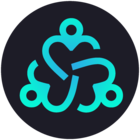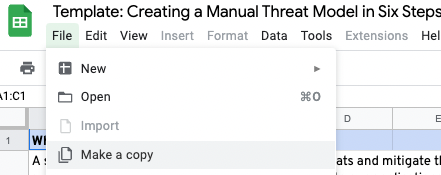Update (Spring 2023): We released v2.0 of the template, along with the recording of a workshop that includes a full demo of how to use this template.
Introduction: What is Threat Modeling
A structured and repeatable process to identify threats and mitigate them against valuable assets in a system. We cannot build secure systems until we understand the applicable threats to our applications/ systems/platforms/infrastructure/services/APIs etc. Threat Modeling involves (i) visually modeling a system (ii) identifying potential threats (iii) validating and/or designing security controls to mitigate risk(s).
Threat Modeling versus Threat Intelligence
While both Threat Modeling (TM) and Threat Intelligence (TI) focus on identifying threats in order to act on them or mitigate them, Threat Modeling aligns well with the Security architecture/design portion of Secure Development Lifecycle, whereas Threat Intelligence aligns well with security operations. Threat Modeling is relevant to identifying threats in a particular system/application/platform/service that we are building before that system is deployed in production, whereas Threat Intelligence is relevant to a comprehensive list of Threats to a whole organization with reference to systems that are already in production/non-prod/pre-prod/laptops/desktops, etc.
Threat Modeling alignment to NIST CSF
Both Threat Modeling (TM) and Threat Intelligence (TI) maps into NIST CSF Identify (ID) → Risk Assessment (ID.RA) category
| Function | Category | Sub-category |
| IDENTIFY (ID)
| Risk Assessment (ID.RA): The organization understands the cybersecurity risk to organizational operations (including mission, functions,image, or reputation), organizational assets, and individuals. | ID.RA-3: Threats, both internal and external, are identified and documented |
A Simple, Six-Step Approach to Threat Modeling
The following describes a simple six-step approach to perform threat modeling:
-
Create an architecture diagram of the application/system by:
-
depicting each architectural component as one of the four threat modeling elements. Any architectural component which is not an actor/data flow/data store would be a process from the threat modeling perspective.
-
assign a number to each architectural component for each reference in later steps.
-
-
List down each architectural component matching the assigned numbers or identifiers in the diagram (eg. as rows in a spreadsheet) along with mapping to the corresponding threat modeling element those components fall into.
-
For each such architectural component, duplicate the row as many times as there are applicable threats based on the STRIDE applicability matrix and assign an applicable threat for that component in each row. For example, for an actor, there would be two rows (one for Spoofing threat and second row for Repudiation threat as there are two applicable threats as per STRIDE applicability matrix. Similarly, there would be four rows for a database, as there are four applicable threats for a data store).
-
Think about how such a threat could make a contact or exploit a vulnerability in the component and manifest into a real risk to the application/system that is being threat modeled. Write down or explain the threat description in a simple sentence or two
-
Think about if the threat is real or not and how a set of security controls (one or many) that are already in place or going to be implemented could mitigate the potential risks. Propose such mitigation plan in a simple sentence or two
-
Identify the appropriate security control(s) from NIST CSF. Each such security control should be placed in the next column on the same row. Note that there could be many-to-many relationships between potential threats and possible mitigation controls. (one security control may mitigate multiple threats and one threat may need multiple controls for risk mitigation).
Let's take a simple internet facing web application architecture to walk through the six (6) steps described above.
Step 1: Create an architecture diagram and label the artifacts
Step 2: List down each architectural component
| Artifact depicted in the diagram | TM Element |
| (1) Human user (customer/employee/partner) using a web browser | Actor |
| (2) Data flow between user/browser and web/app server | Data flow |
| (3) Web Application (app.organization.com) | Process |
| (4) Data flow between web/app server and database | Data flow |
| (5) Database | Data store |
Step 3: Identify and assign potential threats from STRIDE applicability matrix
| Artifact depicted in the diagram | TM Element | Applicable Threats (STRIDE Classification) |
| (1) Human user (customer/employee/partner) using a web browser | Actor | Spoofing |
| (1) Human user (customer/employee/partner) using a web browser | Actor | Repudiation |
| (2) Data flow between user/browser and web/app server | Data flow | Tampering |
| (2) Data flow between user/browser and web/app server | Data flow | Information disclosure |
| (2) Data flow between user/browser and web/app server | Data flow | Denial of service |
Step 4: Describe threat description
| Analyze Model | Identify Threats | ||
| Artifact depicted in the diagram | TM Element | Applicable Threats (STRIDE Classification) | Threat description |
| (1) Human user (customer/employee/partner) using a web browser | Actor | Spoofing | An attacker could pretend to be a valid customer and try to access unauthorized details |
| (1) Human user (customer/employee/partner) using a web browser | Actor | Repudiation | An authorized user (e.g., w/ admin privs) might delete/edit customer data and could claim to have not performed that action |
| (2) Data flow between user/browser and web/app server | Data flow | Tampering | An attacker could modify data as it traverses internet to the web/app server |
| (2) Data flow between user/browser and web/app server | Data flow | Information disclosure | An attacker could sniff network traffic to read sensitive data in transit |
| (2) Data flow between user/browser and web/app server | Data flow | Denial of service | An attacker could launch DoS/DDoS to degrade the availability of a web application/service to users |
Step 5: Propose risk mitigation plan
| Artifact depicted in the diagram | TM Element | Applicable Threats (STRIDE Classification) | Threat description | How we plan to mitigate the risk(s) |
| (1) Human user (customer/employee/partner) using a web browser | Actor | Spoofing | An attacker could pretend to be a valid customer and try to access unauthorized details | Implemented or plan to implement strong authentication |
| (1) Human user (customer/employee/partner) using a web browser | Actor | Repudiation | An authorized user (e.g., w/ admin privs) might delete/edit customer data and could claim to have not performed that action | Implemented or plan to implement log monitoring for operations on sensitive data by users |
| (2) Data flow between user/browser and web/app server | Data flow | Tampering | An attacker could modify data as it traverses internet to the web/app server | Implemented or plan to implement encryption of data in-transit using strong cryptography |
| (2) Data flow between user/browser and web/app server | Data flow | Information disclosure | An attacker could sniff network traffic to read sensitive data in transit | Implemented or plan to implement encryption of data in-transit using strong cryptography |
| (2) Data flow between user/browser and web/app server | Data flow | Denial of service | An attacker could launch DoS/DDoS to degrade the availability of a web application/service to users | 1. Implemented or plan to implement firewalls at appropriate levels in the network to reduce the attack surface 2. Implemented secure network configuration |
Step 6: Identify appropriate security controls from NIST CSF
| Analyze Model | Identify Threats | Mitigation Plan | |||||
| Artifact depicted in the diagram | TM Element | Applicable Threats (STRIDE Classification) | Threat description | How we plan to mitigate the risk(s) | Relevant or applicable NIST CSF control(s) | ||
| (1) Human user (customer/employee/partner) using a web browser | Actor | Spoofing | An attacker could pretend to be a valid customer and try to access unauthorized details | Implemented or plan to implement strong authentication | PR.AC-7: Users, devices, and other assets are authenticated (e.g., single-factor, multi-factor) commensurate with the risk of the transaction (e.g., individuals’ security and privacy risks and other organizational risks) | ||
| (1) Human user (customer/employee/partner) using a web browser | Actor | Repudiation | An authorized user (e.g., w/ admin privs) might delete/edit customer data and could claim to have not performed that action | Implemented or plan to implement log monitoring for operations on sensitive data by users | PR.PT-1: Audit/log records are determined, documented, implemented, and reviewed in accordance with policy | DE.AE-3: Event data are collected and correlated from multiple sources and sensors | |
| (2) Data flow between user/browser and web/app server | Data flow | Tampering | An attacker could modify data as it traverses internet to the web/app server | Implemented or plan to implement encryption of data in-transit using strong cryptography | PR.DS-2: Data-in-transit is protected | ||
| (2) Data flow between user/browser and web/app server | Data flow | Information disclosure | An attacker could sniff network traffic to read sensitive data in transit | Implemented or plan to implement encryption of data in-transit using strong cryptography | PR.DS-2: Data-in-transit is protected | ||
For full threat model, refer to “Threat Model for 2-tier web app” worksheet at:
🔗 Template: Creating a Manual Threat Model in Six Steps (by Shankar Chebrolu) v2.0
Architecture diagrams are on the first worksheet “Architecture diagrams” for additional reference.
Manual Threat Modeling Tool Using a Spreadsheet (Template)
The template for creating a threat model manually in six steps using a spreadsheet is made available at the link below. The template could be customized further to make it work with any security standard or framework instead of NIST CSF or with an organization's internal security standard.
🔗 Template: Creating a Manual Threat Model in Six Steps (by Shankar Chebrolu) v2.0
References
Appendix 1: Primer to STRIDE framework
Threat Classifications
There are six classifications of Threats dubbed as STRIDE (Spoofing, Tampering, Repudiation, Information disclosure, Denial of service, Elevation of privilege) as described below. The STRIDE approach to threat modeling was invented in 1999.
| Threat Classification | Definition | Sample Threats | Desired security control to mitigate the threat | Risk mitigation solution |
| Spoofing | Impersonating something or someone else | Pretending to be a valid user or server | Authentication | Enforce strong authentication techniques like 2FA for human authentication, client certs for non-human (API) clients |
| Tampering | Modifying data/ code unauthorized | Modifying code (or library) on a system / data on disk | Integrity | Enforce strong cryptography/ hashing |
| Repudiation | Claiming to have not performed an action | Remove record of modification of a file / resource | Non-Repudiation | Enforce logging on key events of interest. Use digital signatures |
| Information disclosure | Exposing information to someone not authorized | Gathering sensitive information from log files | Confidentiality | Enforce strong cryptography/ encryption |
| Denial of service | Deny or degrade service to legitimate / | Crashing a website | Availability | Use Throttling to control resource usage or design/build resiliency at the server level |
| Elevation of privilege | Gain capabilities without proper authorization | Allowing remote user to run commands, switch from a limited user to admin | Authorization | Enforce principle of least privilege |
Threat Modeling Elements
There are four elements used in Threat Modeling:
-
Actor - Users (typically human users, but don't need to be. It could be clients like browsers or devices with IP address or physical address)
-
Data Store - Databases, File systems, LDAP, Cookies, Memory-Cache
-
Data Flow - HTTPS, IPSEC, RPC
-
Process (runs code) - Web application/service, OS process, VM/Host/Server
STRIDE Applicability to TM Elements
Not all the threats apply to every element in the architecture diagram. Matrix of the applicability of threats to actors is shown in the table below:
| Spoofing | Tampering | Repudiation | Information Disclosure | Denial of service | Elevation of privilege | |
| Actor | X | X | ||||
| Data store | X | X | X | X | ||
| Data flow | X | X | X | |||
| Process | X | X | X | X | X | X |
Appendix 2: Sample Threat Models
SaaS Application (Public Cloud Hosted)
Refer “Threat Model for SaaS application” worksheet
🔗 Template: Creating a Manual Threat Model in Six Steps (by Shankar Chebrolu) v2.0







